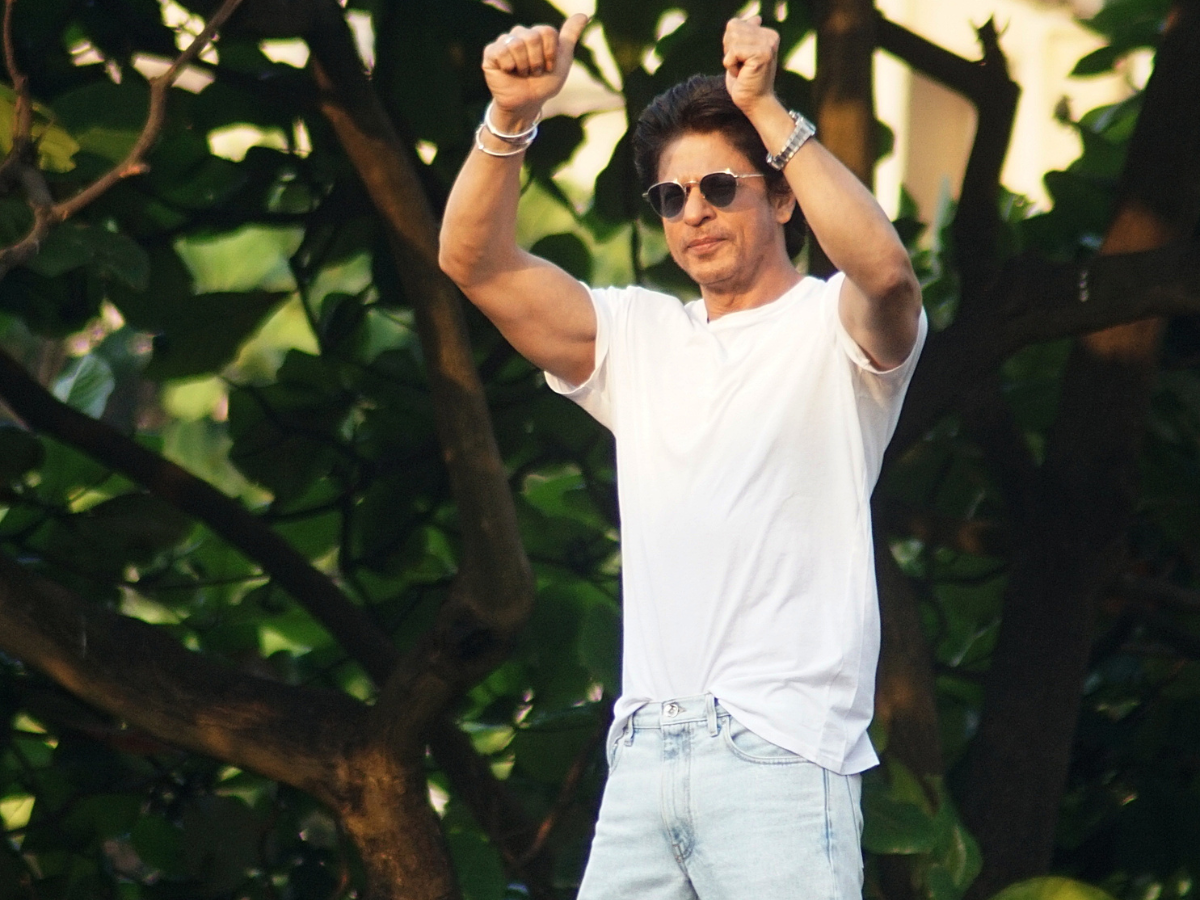Right outside the Mass Communication Research Centre (MCRC) at Jamia Millia Islamia in south Delhi, a cobbler used to sit till mid-2000s. Most students from the university and MCRC would get their footwear mended and polished from him.
Among them was Shah Rukh Khan, who used to study at MCRC and had opted for a career in acting in Bollywood after leaving the course mid-way.
Asked if Khan got his shoes mended from him, the cobbler replied, “Yes! Once. He came to me with a shoe that needed a bit of stitching. He had torn it while playing. I mended it for him and charged Rs 35. But he didn’t have cash at that time. So, he said he shall pay me later. It is a common thing here; sab chalta hai. Sab de jaate hain paise. Koi rokta nahi (It’s a norm here. Students pay later. No one keeps my money).”
“But,” with a smile on his light-bearded face and a bidi beneath his teeth, the 40-year-old said, “Shah Rukh didn’t pay my Rs 35. He had to leave for Bambai (Mumbai) perhaps. Aisa bhi ho jata hai kabhi kabhi (this also happens at times). He didn’t come this side again.”
This correspondent asked him, “Shall I send a message to Shah Rukh that he owes you this money?”
The cobbler broke into a grin and said, “Nahi madam, Rehne dijiye (No, let it be). That the country’s biggest and such a rich actor owes me money, is an elevating feeling in itself. Main keh sakta hoon Shah Rukh Khan ke upar mera udhar hai. Ab vo aa bhi jayenge to nahi mangoonga. (I can say Shah Rukh Khan owes me money. Even if he comes here, I won’t ask for it).”
Saying this he burst into a playful laughter. The students around him, all confirmed SRK fans, clapped for him as if it was them who owed the money! This reaction of the cobbler never allowed this film correspondent to tell Khan about it although one doubted it could be a made-up story too! After all, it was Shah Rukh Khan.
Media’s most loved personality
There are many reasons why Shah Rukh Khan is popular among media-persons.
The most important quality is his chivalry, his talkative self that barely allows two questions in a row, as he answers them all in one, his sense of humour and a sense of belonging that he creates in his meetings with scribes individually and in press conferences.
Sample this. Khan had come to Delhi-NCR for a mega event when his blockbusters were ruling the film horizon. He was supposed to arrive at around 8.30 pm but ended up reaching at 12.30 at night. He was stealthily brought to back area especially meant for journalists – away from the audiences. This correspondent, the first one to meet him, asked him quick questions knowing that there would soon be a slew of reporters surrounding him.
We had barely finished the last one when someone shouted, “Aa gaya Shah Rukh! (SRK has arrived).” Within a fraction of a second, hundreds of television journalists with cameras thronged him, giving him no space to stand. Khan noticed the massive crowd about to swallow this correspondent.
Khan enveloped this correspondent protectively without letting his arms touch one. One could smell the light perfume he was wearing, “Arey yaar,” he almost screamed, “Dekh to lo (watch it)! Here is a lady standing with me and you are pushing her; have some decency yaar!”
A second later, he asked, “Madam, have you finished your questions?”
One replied, “Have a couple of more.”
“Please go ahead,” he said. He brought his ears close in the din created by the crowd and music.
After the interview, Khan escorted this correspondent till a distance before bowing with elan in response to Khuda Hafiz. Not tall himself, Khan got immersed into the colossal mass within seconds.
Paheli’s failure
Khan’s Paheli, which he was taking to Oscars, was another occasion when he chose to call this correspondent from Mumbai. He would leave no stone unturned to promote Paheli and the symbolism it had.
Despite 15 minutes allotted for the phone interview, Khan generously spared 45 minutes.
It was clear during the interview that SRK was constantly reinventing himself. He spoke about the philosophy of life, its transient-ness, symbolism, poetry of love and love in togetherness. This was Khan in 2005, veering towards thought-provoking readings and sharing them with journalists who seemed interested in it.
The film failed at the box office. Cinemagoers of that time perhaps didn’t understand that an entire film could be made like a poetry – same as MF Husain’s Gaja Gamini, which too didn’t do well at the box office.
Paheli had numerous colourful songs from Rajasthan about love and separation, which spectacularly ornated the movie. Unfortunately, a few labelled the film as chitrahaar (a programme of songs popular in 80s and early 90s) just like Hum Dil De Chuke Sanam of Sanjay Leela Bhansali, not realising that these well-choreographed songs turned global attention to India’s diversity celebrated through such films.
Fan moment
Khan almost stopped doing press meets following some experiences like at a press meet in Delhi for his film Fan. He left within 15 minutes of arrival with his director Manish, joking around with some reporters and addressing as tum to some as he answered questions on personal life, his religion and faith, favourite song among others.
Camerapersons didn’t allow questions, since it was selfie time with him. Within minutes, Khan and the Fan team was engulfed by a marshland of shutterbugs.
Controversies around his frisking at an airport, his religion, destructive criticism by certain tabloids and television channels, seemingly held Khan from appearing for press.
He, however, does public shows for fans in which his own team becomes the interviewer and the media picks ‘bytes’ or ‘quotes’ from there – certainly discouraging for serious journalists.
Khan, instead, invested his time in marketing and promotions.
A coffee-table book by his close friend Mushtaq Khan titled Still Reading Khan in late 2000s was added to it. Khan never disappeared from media therefore, whether or not he was available for interviews physically.
Added to the investment was his habit of reading and stepping towards spirituality.
Khan has not changed from the time he was in Delhi, praying for his mother’s life at the parking of All India Institute of Medical Sciences (AIIMS) in the 1980s when he used to drive a Maruti 800, and till later this year when he was hailed among the most popular and richest actors in the world.
The things that changed in him professionally are a few verticals — his marketing, promotions, talks at universities in the country and abroad, and at fora like TED, as well as philanthropy. Everything has been done step by step. As for media relations, he has adopted the Gandhian way.
For instance, an anchor reporter had slung mud on him with an agenda her media house is ill-known for. Khan went there, hugged the correspondent and gave an interview in their studios! This is his way of turning an apparent foe to a friend who was seen hugging him back after the show. The pictures went viral and served Khan’s purpose of putting the debate to rest, humbly, and how! The mud-slinging reporter had to bite the dust.
Extending an olive branch to controversy creators is Khan’s best move as much as his efforts to keep creating a demand for himself almost all the time. For instance, Khan is not doing media interviews in the run up to his film releases for last few years and Dunki his latest, due release on December 21, is no exception. The whole star cast is following suit. His wife Gauri Khan is the producer after all.
Irrespective of how the film fares at the box office, its song Lut Put Gaya has gone viral. Children are dancing to it, making videos and posting on social media, A strategy to release his old videos of ‘home-coming’ to Delhi, is a smart and symbolic Dunki promotion without talking about it upfront.
The film is about going abroad to make a good living, joining forces for want of recognition and employment and coming home to the loved ones. In this Raj Kumar Hirani film that has Taapsee Pannu, a Delhi girl, as its lead heroine, Boman Irani and Vicky Kaushal – all seem to have taken a back seat. SRK leads.





